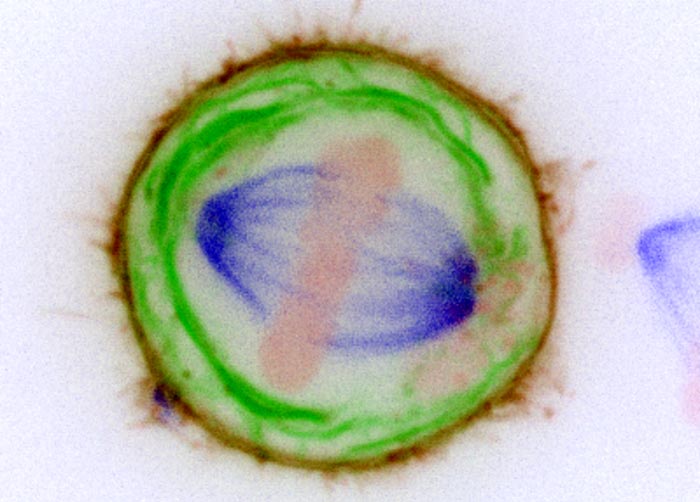Cancer origin identified through cell ‘surgery’

Chromosomes (shown in pink) are shared by the spindle (blue). Membranes (green) are a risk factor for correct chromosome sharing.
Credit: University of Warwick
Research from the University of Warwick sheds new light on a key cause of cancer formation during cell division (or mitosis), and points towards potential solutions for preventing it from occurring.
- When a cell divides abnormally, it does not share the correct number of chromosomes with the two new cells, and this can lead to cancer
- New research from Warwick Medical School has discovered why and how this happens, using ‘cell surgery’
- Understanding the origin of abnormal cell division and cancer formation can lead to prevention
When a cell divides normally, it makes a copy of every chromosome and then shares them equally between the two new cells. This function is carried out by a complex machine in the cell called the mitotic spindle.
If something goes wrong at this stage, the two new cells will be aneuploid, meaning that they will not have the correct number of chromosomes and will make mistakes when sharing genetic information.
Cancer cells are aneuploid, so understanding how and why this happens is hugely significant in finding out how the disease originates.
Professor Stephen Royle’s research team at Warwick Medical School has identified exactly this.
They found that some chromosomes can get lost and trapped in a tangle of membranes that exist in an area around the cell’s spindle, preventing the chromosomes from being shared properly and leading to the abnormal cell division that can cause cancer.
They made their discovery by performing a sort of ‘surgery’ on living cells. The researchers invented a way to remove the tangle of membranes in which chromosomes get trapped, and as a result the chromosomes were rescued by the spindle, thus enabling normal healthy cell division.
This proved, for the first time, that chromosomes getting caught in these membranes is a direct risk factor for the formation of cancerous cells. Understanding this risk can lead to more effective cancer prevention.
Stephen Royle, Professor of Cell Biology at Warwick Medical School, commented:
“Many scientists working on cell division focus on the spindle: how it works and why it makes mistakes in cancer. In this paper we shifted the spotlight and looked at membranes inside dividing cells.”
Dr Nuria Ferrandiz, lead author of the study, said:
“We found that chromosomes can get trapped in membranes and this is a disaster for the dividing cell. It has the potential to change a normal cell into a cancer cell. Preventing this process may be a way to treat disease.”
Notes to editors:
The paper, ‘Endomembranes promote chromosome missegregation by ensheathing misaligned chromosomes’, is published in the Journal of Cell Biology. Read full paper here.
DOI: https://doi.org/10.1101/2021.04.23.441091
Authors: Nuria Ferrandiz, Laura Downie, Georgina P. Starling, Stephen J. Royle.
The research was funded by Cancer Research UK.
Journal: Journal of Cell Biology
Method of Research: Experimental study
Subject of Research: Cells
Article Title: Endomembranes promote chromosome missegregation by ensheathing misaligned chromosomes
Article Publication Date: 29-Apr-2022
Media Contact
Luke Walton
University of Warwick
L.Walton.1@warwick.ac.uk
Office: 07-824-540-863
All latest news from the category: Life Sciences and Chemistry
Articles and reports from the Life Sciences and chemistry area deal with applied and basic research into modern biology, chemistry and human medicine.
Valuable information can be found on a range of life sciences fields including bacteriology, biochemistry, bionics, bioinformatics, biophysics, biotechnology, genetics, geobotany, human biology, marine biology, microbiology, molecular biology, cellular biology, zoology, bioinorganic chemistry, microchemistry and environmental chemistry.
Newest articles

Innovative 3D printed scaffolds offer new hope for bone healing
Researchers at the Institute for Bioengineering of Catalonia have developed novel 3D printed PLA-CaP scaffolds that promote blood vessel formation, ensuring better healing and regeneration of bone tissue. Bone is…

The surprising role of gut infection in Alzheimer’s disease
ASU- and Banner Alzheimer’s Institute-led study implicates link between a common virus and the disease, which travels from the gut to the brain and may be a target for antiviral…

Molecular gardening: New enzymes discovered for protein modification pruning
How deubiquitinases USP53 and USP54 cleave long polyubiquitin chains and how the former is linked to liver disease in children. Deubiquitinases (DUBs) are enzymes used by cells to trim protein…



